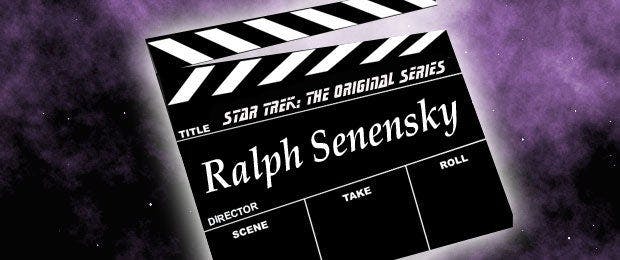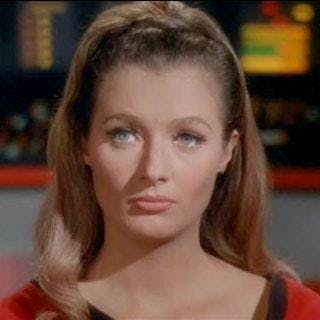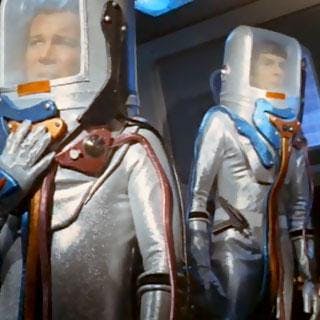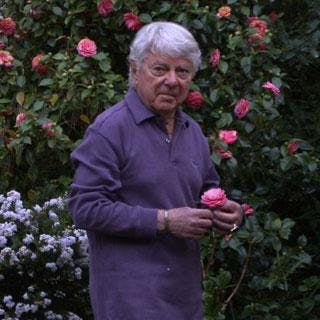Published May 22, 2012
TOS Director Ralph Senensky, Part 2
TOS Director Ralph Senensky, Part 2


After “Bread and Circuses,” you directed “Obsession.” Your main guest was Stephen Brooks as Garrovick and you were working with an intriguing storyline that mixed Moby Dick and a whodunit story…
Senensky: The shoot was a very pleasant one. I think the script was very tight. I think Gene Coon had left already, but he’d just left, and I felt that he’d still had great input into the script. He might even have rewritten a lot of it. For me, it doesn’t rank in the top two with “Paradise” or “Metamorphosis,” but it’s just in the run below. Stephen Brooks was a wonderful talent. I’d met Steve for the first time in 1963, when he was a regular on The Nurses, in New York. A year or so after that he came out to L.A. and was a regular on The F.B.I. for the first two seasons. By the time he did Star Trek I had worked with him 13 times. I thought he was a very good, solid and attractive actor who really got screwed by Hollywood.
For some reason, he was let go from The F.B.I. after the second season. I, at the time, wasn’t sure whether it was Quinn (Martin) or the network that wanted to dump him. At first, I thought he’d left for personal reasons, maybe to get away from the limitations of the series and to branch out. But then I found out that his contract was not picked up, that it was the network that did it, but I’m not sure why. It really kind of destroyed him. We did Star Trek the following year and then I worked with him one more time, in the 1970s, on a medical series over at Columbia that didn’t take. Sometime in the latter part of the 70s, he left Hollywood and went up to Seattle. A few years ago, after I started my blog, I got a letter from a lady who said she had met him and said he was a very sad man. He died at age 57 of massive heart problems. He was a very, very fine talent and a very conscientious actor. If you look at his work, the detail in his performances is just wonderful.
Eddie Paskey, who appeared in many episodes of TOS as Lt. Leslie, died on screen, only to return as the same character in the same episode. He has said that there was a scene cut in which Leslie was saved by a miracle potion. That scene ring a bell to you?
Senensky: I didn’t shoot one. I didn’t shoot one.
The next episode you did was “Return to Tomorrow.” That is not among your favorites…
Senensky: On my site, where I talk about my Star Trek shows, that’s the one I don’t talk about as much. We worked hard at it. I had Diana Muldaur, who I’d worked with several times already, and she was a wonderful leading lady. It gave Leonard a chance to break off, to break away from Spock and basically play this other character who was using Spock’s body. But there was something about the script that I just didn’t think worked. I have read since, really recently, that the original author and Gene Roddenberry had a very different approach and a different interpretation of what that script was, and that Gene did quite a bit of rewriting, to the point that the original writer took his name off and used a pseudonym, used an alias.

You had Diana Muldaur yet again as your leading lady for your next episode, “Is There in Truth No Beauty.” How often in those days did that kind of thing happen?
Senensky: It hardly ever happened on Star Trek. They had a rule against it. They had an absolute rule against it. On some shows, like The Fugitive, like The F.B.I., they’d bring back any actor, any time. If the producers liked you, or the director liked you, you’d be almost guaranteed to be back once a year. Star Trek, it was an absolute no-no. When it came time to casting Miranda Jones for this Star Trek episode, I remember checking around, and we checked out Jessica Walter. I’d worked with her before, but she wasn’t available. We checked out other people and there just didn’t seem to be anybody. I said, “Well, why don’t we put a black wig on Diana Muldaur and bring her back?” They’d liked her and I loved working with her. Eventually, when we couldn’t find anyone else, they said yes. Of course, at the dailies for the first day’s work, Bobby Justman said, “I wonder how she’s going to look in a red wig?”
This episode also gave us the infamous IDIC story…
Senensky: Yes, it did. We had a major, major, major problem the first day. We were to do a dinner scene with, I think, six or seven people, including Leonard, Diana, Bill, Doc, Scotty, David Frankham (who played Marvick). Leonard was wearing a pin, an IDIC. We arrived at the studio, ready to shoot, and Leonard and Bill said that they didn’t want to do the scene because they felt that it was a promotion for the IDIC pin, which was something that Gene Roddenberry had designed. They felt he was doing it to promote it, so that he could sell it. As I’ve learned, just recently, doing my site, Leonard called Fred Freiberger, the new producer, to object and to see about getting something done. Nothing was done. Fred Freiberger refused to do anything.
Leonard then called Gene Roddenberry, and Gene came to the set. We spent the morning, the full morning, all of us, sitting in a circle, but the ones who were talking were Bill and Leonard and Gene. Gene was defending the IDIC and saying, no, this was not a promotion, that he was not doing it to sell a pin. The boys insisted that they felt it was commercialization. Gene ended up agreeing to rewrite, and I lost the morning. That scene was now not available until Gene went and rewrote it. So I pulled a scene out and, fortunately, Diana and David halfway knew what it was, and they did a remarkable job, because it was a big, big, heavy scene.
Your thoughts on the final episode?
Senensky: The show itself is fine. I had one major objection. By the time that went into post-production, the following show that I did was the big web (“The Tholian Web”). So I was not around, and they added special effects, in terms of the ambassador in the box, to turn him into a monster, which he wasn’t. The things they were doing were so counter to the intent of the script. If I watch the show, when it gets to those scenes, I just close my eyes.
You just mentioned “The Tholian Web.” You directed about half of it before Fred Freiberger dismissed you. Take us through the timeline of what happened with that episode…
Senensky: During prep, I had a call from my agent that Gene Coon, who was now producing It Takes a Thief over at Universal, wanted me to go do that show. I’d love to have done it, but there was an overlap and I wouldn’t be finished with “The Tholian Web” in time. So I had to turn it down. “The Tholian Web” was not as character-driven a story as I liked to do. It was fine, though. I could do those kinds of shows, but I did prefer shows that were based on character and relationships. That was not that kind of a show, but I was interested in doing it. Monday morning I arrive at the studio to do the sequence with the four men – Kirk, Spock, Doc and Chekov. They’re in silver lame spacesuits, going over to another spaceship, which was going to be the Enterprise doubling, where they discover that the whole crew is dead. They go through the ship section by section and they just find dead bodies and dead bodies in very strange, violent positions.

Friends came to visit me and we went next door to visit the Mission: Impossible set, where Ruth Roman was working, and I’d worked with her on two or three things. So we spent some time over there, and then came afternoon, and we went to work and did the best we could. Then we had another problem, from 1 o’clock until the end of the day. The guys had to go to the restroom. When they went to the restroom that meant they had to be un-sewn from their spacesuits, go do their business, come back, be re-sewn into the spacesuits. That’s the way we muddled through the day and, at the end of the day, I was a half a day behind.
That’s when the real trouble started…
Senensky: The next day, we continued working. There were some big production shots, things down in the engineering room, wide shots with action, violence that was happening because of whatever it was in the air affecting the people. Anyway, we got through Tuesday. We got through Wednesday. At the end of it Wednesday, I was called up to Fred Freiberger’s office and was told that I was being replaced because I’d not caught up my half day. The following day, The Hollywood Reporter and Daily Variety had news articles telling about my being fired. It was issued by Doug Cramer’s office. He was saying that these schedules had to be met and he was making a point that he was going to see that they were met, and I was the point.
Gene Roddenberry called you directly and was deeply apologetic. What did that mean to you?
Senensky: Yes, he did. It was nice to hear. I was aware that Gene was not involved in the decision. I also knew that Gene, by this point, was not that thrilled with the way things were running. And I think before the end of the year, he too sort of abdicated. Because of the two articles that ran I did not work for months. It wasn’t a matter of going from that to some other job. It was like I was all of a sudden on a blacklist. I did not work until the end of the year when Jimmy Komack over at The Courtship of Eddie’s Father called me in to talk to me about doing that show. The head of the studio was Herb Solow, who’d moved from Desilu over to MGM when Paramount took over. Herb did make a point to come down to the set to see me and to tell me that when Jimmy asked about using me Herb said, “I did not say no.”
Did you ever talk to Herb Wallerstein, who replaced you on “The Tholian Web” and received full credit for the episode?
Senensky: No. No, no, no. I did go to Director’s Guild. They wanted to hear my side of the story. I gave it to them. The only thing I said was to insist that I wanted my share of the residuals, but I did not want my name on the show. My name is not on the show, and not until the Internet came along did my name start getting connected to the show.
Did you ever watch the full episode?
Senensky: I didn’t for a long time. I probably watched it once and then avoided it for many, many years. And I have watched it since.
You directed countless episodes of other shows throughout your career. If someone reads this article and wants to check out some of your non-Trek work, what might you steer them toward?
Senensky: Naked City. Route 66. The Waltons. Dr. Kildare. Twilight Zone. The Courtship of Eddie’s Father. The Paper Chase. I did the Dynasty pilot. The Fugitive. 12 O’clock High, the first year, in black and white, before ABC decided to turn it into a kids’ show and go to color. I did a lot of one-shots, too. But those are the ones I like.

Last question: what are you up to these days?
Senensky: I’m living a wonderful retired life. Have you ever been to Carmel-by-the-Sea? You should come here. It’s just a little village, although we’re a part of the Monterey Peninsula. It’s a small town of 4,400, but most of the homes in town are second homes, so that there are maybe 2,000 people living in the town. I live 10 blocks from the water and I walk to the beach every day. I work on my website. I started it as a blog and, come September, it’ll be three years. A year ago March I decided to redo it in even more detail, and so the website started up March 7. That keeps me busy and it keeps me in touch with people.
To read part one of our interview with Ralph Senensky, click HERE. Click HERE to watch an extensive, career-spanning video interview with him conducted by the Archive of American Television. And click HERE to visit his official site.
